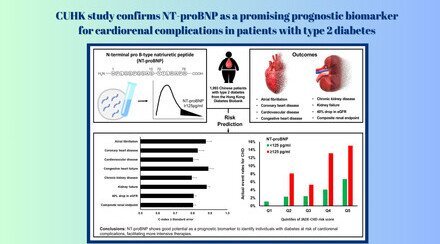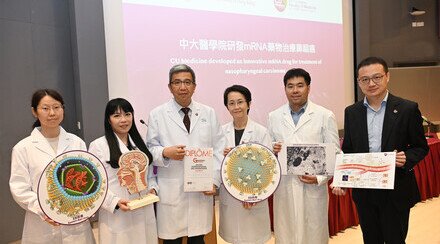CUHK Uncovers How Immune Cells Turn Bad A New Hope for Kidney Patients
Macrophage is a type of white blood cell that serves as a soldier in our body, responsible for detecting, engulfing and destroying pathogens and unhealthy cells. A new study by the Faculty of Medicine at The Chinese University of Hong Kong (CU Medicine) has uncovered dynamics of macrophages in a diseased kidney, which can cause tissue scarring that eventually results in an irreversible renal failure.
The research team has discovered that hyperactivated macrophages can directly transform into tissue scarring accelerator myofibroblasts in the diseased kidney, where cells are abnormally expressing a brain-specific gene - POU4F1. Their preclinical study with gene therapy effectively blocked renal failure by targeting macrophage’s POU4F1, opening a new direction for kidney therapy. This finding has been published in the prestigious international scientific journal Proceedings of the National Academy of Sciences (PNAS).

From left: Dr. Patrick Ming Kuen TANG, Professor Hui Yao LAN and Professor Ka Fai TO
Rebalancing the immune system becomes a new strategy for kidney disease
Kidney is one of the major organs in our body for detoxification. Kidney failure is an important cause of patient mortality that serves as a primary disease and a lethal complication in a range of diseases such as diabetes, cancer, bacteria, and virus infections including COVID-19; resulting in more than 6 million patients receive renal replacement therapy worldwide. However, this urgent area of clinical need is still unmet due to the lack of effective treatment. Encouragingly, scientists have started to recognise that hyperactivation of our immune system is critical for promoting organ failure.
Macrophage is a well-documented immune cell type for maintaining the health of our kidneys. They are responsible for pathogen clearance and tissue repair, but paradoxically their preponderance also accelerates organ failure. A better understanding of the underlying mechanisms would separate out the unwanted actions of macrophages form a diseased kidney.
Professor Hui Yao LAN, Choh-Ming Li Professor of Biomedical Sciences from the Department of Medicine and Therapeutics at CU Medicine elaborated, “Recently, we discovered that long-term hyperactivation of macrophages will direct their transformation into a pathogenic cell type myofibroblast in the diseased kidney which promotes tissue scarring via a novel phenomenon ‘Macrophage–Myofibroblast Transition (MMT)’. This is a critical step for starting the loss of kidney function.”
Macrophage–Myofibroblast Transition is a new therapeutic direction for kidney failure
The CUHK team further discovered that abnormal expression of POU4F1, a transcription factor for sensory neurons development, in the kidney-infiltrating macrophages is essential for initiating MMT. Inhibition of POU4F1 can thus block the generation of myofibroblasts from MMT and therefore stopping kidney failure.
Dr. Patrick Ming Kuen TANG, Assistant Professor of the Department of Anatomical and Cellular Pathology at CU Medicine explained, “The functional importance of a brain-specific gene POU4F1 in kidney disease was unexpectedly revealed by utilising our latest bioinformatic approach through reconstructing the regulatory gene network of MMT at single-cell resolution. This novel observation stimulates us to hypothesis that targeting POU4F1 precisely on the macrophages may protect patients against kidney failure.”
Inspired by these findings, related preclinical works have been started by treating two mouse kidney disease models with gene therapy. Results have shown that silencing of POU4F1 specifically on the macrophages effectively prevented tissue scarring by blocking the formation of myofibroblast as well as other pathogenic factors from MMT in the injured kidney. Part of the discovery has earned Dr. Tang a Faculty Innovation Award from CU Medicine in 2019.
Professor Ka Fai TO, Chairman of the Department of Anatomical and Cellular Pathology at CU Medicine commended, “Immunotherapy shows promise in cancer treatment and its implications in other diseases has begun to be explored. Our study has identified a new immune regulator for promoting organ failure and developed a novel immunotherapeutic strategy to protect patients against kidney disease.”
Professor Lan added, “We have invented an innovative virus-free method for gene therapy. This can be further developed as a novel, effective and safe treatment for kidney diseases by precisely silencing Pou4f1 in the renal tissue.” The research team is also developing specific inhibitors for blocking MMT, which may open up a new direction of immunotherapy against kidney disease.”
This study was supported by the CU Medicine Faculty Innovation Award, Hong Kong Research Grants Council, Health and Medical Research Fund, Innovation and Technology Fund, Guangdong-Hong Kong-Macao-Joint Labs Programme from the Guangdong Science and Technology Department and Lui Che Woo Institute of Innovative Medicine (CARE programme). Other main contributors of this study include Prof. David J. Nikolic-Paterson of Monash University, and Dr. Yingying ZHANG, Dr. Jun Xiao and Dr. Philip Chiu Tsun TANG of CUHK. The original study can be accessed here: https://www.pnas.org/content/117/34/20741.

























